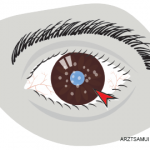To help prevent HORV, the researchers advise surgeons to consider the potential risk of HORV associated with vancomycin compared with the risk of endophthalmitis; reconsider the use of vancomycin with close sequential bilateral cataract surgery, especially when performing immediate sequential same-day bilateral surgery; know that HORV onset may be delayed, HORV may not cause symptoms in the first eye, and the only way to detect it may be by dilated retinal exam, if using intraocular vancomycin with sequential cataract surgery; and consider cefuroxime or moxifloxacin instead of vancomycin.
The authors recommend that doctors manage HORV by avoiding intravitreal vancomycin if they suspect HORV; if the diagnosis in not clear, considering an ocular or systemic workup, or both, for other syndromes; aggressively treating with systemic and topical corticosteroids, and considering periocular or intraocular steroids; giving early anti-vascular endothelial growth factor (VEGF); and performing early panretinal photocoagulation.
The authors urge doctors who have patients with HORV to submit their anonymous clinical data to the HORV registry.
Dr. Colin A. McCannel of the Jules Stein Eye Institute at the University of California, Los Angeles, tells Reuters Health, “HORV is a horrible blinding disease. This study is an important reminder of the potential for unintended detrimental consequences of new treatments. On the practical side, there seems to be a strong enough link between this condition and the use of vancomycin to encourage cataract surgeons to consider spacing out surgeries in which vancomycin is used to avoid bilateral disease.”
“While HORV is extremely rare, the severity of bad outcomes might justify re-evaluating entirely the administration of vancomycin as an infection prophylaxis during cataract surgery,” adds Dr. McCannel, who was not involved in the study.
Results of the study were presented at the American Society of Retina Specialists Annual Meeting in San Francisco in August 2016.
Reference
- Witkin AJ, Chang DF, Jumper JM, et al. Vancomycin-associated hemorrhagic occlusive retinal vasculitis: Clinical characteristics of 36 eyes. Ophthalmology. 2017 Jan 19. pii: S0161-6420(16)31231–31233. doi: 10.1016/j.ophtha.2016.11.042. [Epub ahead of print]


